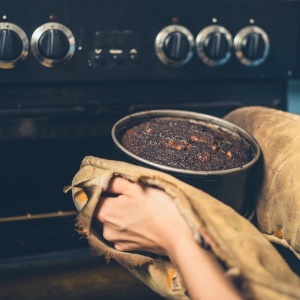(image: iStock)
I am one of those ridiculously brand loyal people that will stick with the same brand I have always used and that my mom and granny used too, especially when it continues to deliver the same great baking results.
Call me “vintage” but there is something endlessly pleasing about opening up a tin of baking powder that hasn’t changed much in 100 years. It immediately invokes memories of baking chocolate cakes with my sister, and fighting over who would get to lick the beaters. Ah, nostalgia!
ALSO READ: 10 Insane cakes you need to make at least once
If you enjoy baking but simply can’t get your precious cake to come out the oven looking perfect, these might be one of the reasons…
1. Adding too much baking powder can result in your cake having a distinct peak on the top as a result of too many air bubbles in the mix. Always measure carefully.
2. Using old or stale baking powder, or baking powder that has been improperly stored, can result in not enough rise, and flat dense cakes.
3. If your cakes have a dip in the middle, that is most likely the result of not baking long enough in the oven, causing the middle not to set completely and the middle to dip down once the cake has been removed from the oven.
4. As soon as the water is added to the baking powder the air bubbles are released, so leaving your batter to stand after mixing can also result in flatter, denser cakes.
How does a raising agent actually work?
Raising agents are the magical chemistry that makes cakes and other baked goodies rise. With the addition of water, the baking powder makes tiny bubbles of air. As the cake bakes, the heat from the oven makes the air bubbles expand and causes the cake to rise. The heat from the oven will eventually set the eggs in the mixture and cake will stay “risen” even when removed from the oven.
What about yeast?
Yeast is classified as a leavening agent, and is actually a biological agent (a type of fungus) that feeds off the sugars in the dough and lets off carbon dioxide gas bubbles. These bubbles work in a similar way, causing the bread to rise. The major difference between baking powder and yeast is that yeast brings its own distinct yeasty flavour, which is not always desirable in cakes.
What about recipes with no raising agents?
Some recipes rely on mechanical methods of incorporating air bubbles into the mixture (like whipped egg whites). Eggs have a magic all their own as in the case of choux pastry where the eggs alone give the pastry air without the aid of any raising agents. These types of recipes can be that much more “hair raising” (excuse the pun) because they rely entirely on your elbow grease and careful mixing to ensure rising.
What is the difference between bicarb and baking powder?
Bicarbonate of soda is actually one ingredient in baking powder. By itself, bicarb (also called baking soda in recipes) will give your product a “soapy” or “soda” taste and will cause your baked goods to darken in colour. This effect can be combatted by adding an acid (like buttermilk, vinegar or lemon juice) as you would with a red velvet cake for example. In the case of baking powder, calcium phosphate and sodium phosphate salts (which are mildly acidic) are added, thus preventing the soda taste and keeping the flour white.
How to make your own self-raising flour
Self-raising flour is a normal wheat flour that has baking powder and a little salt already mixed into it. You can make your own at home in a jiffy.
Homemade self-raising flour:
• 1 cup all-purpose flour
• 1½ teaspoons baking powder
• ¼ teaspoon salt
Mix all the ingredients together well, making sure that the baking powder is well distributed through the flour.

